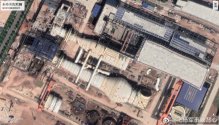You are using an out of date browser. It may not display this or other websites correctly.
You should upgrade or use an alternative browser.
You should upgrade or use an alternative browser.
Chinese Aviation Industry
- Thread starter FriedRiceNSpice
- Start date
If China manages to put maglev lines into operation that will likely increase train speed by another 200-300 kph. Making HSR even more competitive with airline travel. Speeds will likely go from the current 350 kph to 600 kph. But due to expense I expect these maglev lines to only be built for the more congested routes like Beijing - Shanghai, or Beijing - Guangzhou.I believe that air travel does have an important role for certain types of trips in China.
I also recently traveled from Shenzhen to northern China. The high-speed rail was an 8-hour trip. Tickets were uniformly sold out since it was the Chinese New Year. Tickets are commonly sold out during the holiday season.
In the end, I bought plane tickets. The plane ride was a 3-hour trip, and tickets were available - albeit expensive - during the Chinese New Year.
For certain trips, in my opinion, air travel is vital. This is especially the case for north-south voyages. For instance, the Guangzhou/Shenzhen <=> Beijing route is extremely common in China and essential for the economy. High-speed rail takes 9 hours or more, whereas planes take 3 hours. In this case, it is very important to have the flight option. Especially when it's a holiday season and the high-speed rail tickets are sold out, as they always are.
by78
General
This is a pretty big deal.
China has put into service the world's largest vibration simulation system. The system can simulate vibration environments experienced by large turbofans, rocket engines, satellites, automotive and high-speed rail components, etc. Until now, vibration testing on oversized equipment had to be conducted at the component or sub-system level and on a piecemeal basis; this new simulation system can now test them in their fully assembled states.

Two smaller vibration simulators China commissioned previously.
1) A 70-ton vibration simulator developed by the 702nd Institute of CASC for China's space program and commissioned back in 2016. For a time, it held the world record for the largest vibration simulator:

2) A 20-ton vibration simulator, also one of the largest in the world:

A Google Earth image that allegedly shows a large wind tunnel under construction. Does anyone know where this is?

From @JosephWen___ on Twitter, a Taiwan-based PLA observer who can be considered reliable:
Coordinate: 31.42963, 104.66782
The 29th Experimental Training Base of the People's Liberation Army China Aerodynamic Research and Development Center (Unit 63820).
This place has been under construction for a long time, so it's not special news.
Last edited:
lcloo
Captain
City of Mianyang, 100km North East of Chengdu city. Google image date is 2022, June 07th. They should have completed the construction by now.From @JosephWen___ on Twitter, a Taiwan-based PLA observer who can be considered reliable:
by78
General
A Google Earth image that allegedly shows a large wind tunnel under construction. Does anyone know where this is?

This could be the high-altitude engine test bench project that was revealed back in 2020.

Previous posts on this subject:
The has successfully completed testing. It will be used in the upcoming high-altitude engine test bench. It's capable of moving air at 20,000 to 25,000 cubic meters per minute and has a pressure ratio of 8 to 9, which is the highest in the world among industrial axial compressors. The unit has a total length of 11.5 meters, a width of 5.7 meters, and a height of 4.5 meters; the total weight is more than 400 tons. The core component of the hollow rotor is nearly 11 meters in length, weighs nearly 70 tons, and the inner diameter of the rotor is 1.4 meters.

So basically, China is going for something similar to . It will be a critical piece of infrastructure for developing future military as well as civilian engines, especially high-bypass turbofans. Quite a few of these large axial compressors will be installed at the facility, divided among the test cells. And just like the ASTF, I'm sure it will come with an onsite supercomputer as well. A milestone development for sure.
ASTF facility from the outside:
View attachment 63112
One of the large ASTF test cells, large enough for testing high-bypass turbofans:
View attachment 63113
This one is existing High altitude test bench facility.. that PLA have been using for decades.This could be the high-altitude engine test bench project that was revealed back in 2020.


Previous posts on this subject:
Showcase during Zhuhai Air show 2022 ..
This facility won the "Top Ten National Science and Technology Achievement Awards" and "National Science and Technology Progress Award Special Award", in 1995 and 1997 respectively..
red circle... certificates and shield also present..

your previous post on this topic is also related with this facility. in 2020 they upgraded that facility to accommodate bigger Turbofan engines..
The has successfully completed testing. It will be used in the upcoming high-altitude engine test bench. It's capable of moving air at 20,000 to 25,000 cubic meters per minute and has a pressure ratio of 8 to 9, which is the highest in the world among industrial axial compressors. The unit has a total length of 11.5 meters, a width of 5.7 meters, and a height of 4.5 meters; the total weight is more than 400 tons. The core component of the hollow rotor is nearly 11 meters in length, weighs nearly 70 tons, and the inner diameter of the rotor is 1.4 meters.



----------------------------------------------------------------------------------------------------------------
now your current post is really interesting ..
if this is latest imagine then this has to be a brand new Wind tunnel under construction ..

Last edited:
Its also ridiculously dangerous to fly over Tibet since its incredibly mountainous with no places to ditch the aircraft in the event of an accident. Its why most airlines tend to avoid that area.I heard it is not a good idea to fly directly to Xizang unless you are well acclimated to high altitude.
Demand is also low because of such limitation.
I heard it is not a good idea to fly directly to Xizang unless you are well acclimated to high altitude.
Demand is also low because of such limitation.
Its also ridiculously dangerous to fly over Tibet since its incredibly mountainous with no places to ditch the aircraft in the event of an accident. Its why most airlines tend to avoid that area.
Many people do fly to Xizang as tourists, though the reason for the comparatively lower demand is mainly due to the requirement of visiting permits for foreigners to visit Xizang that needs to be applied beforehand.
In the meantime, what really deters airlines from overflying the Xizang Plateau is the high altitude of the complex mountainous terrain.
Commercial airliners today typically cruise at altitudes of 31-38 thousand feet (9400-11600 meters). However, during emergencies such as engine failure or cabin depressurization, airliners are required to descend to around 10 thousand feet (~3000 meters) of altitude within limited period of time, as the atmosphere at lower altitudes is thicker and have plenty of oxygen, which is suitable for attempts to restart engine or permit passengers and crew to breathe without requiring oxygen tank support.
However, the Xizang Plateau has an average elevation of 4500 meters, i.e. way above the ~3000 meters of altitude required for airlines to descend to in case of certain emergencies. Commercial airliners would have struck mountains before getting breathable air over the plateau.
Besides, given its terrain and elevation, Xizang Plateau is sparsely populated, meaning much fewer airports with sufficient runway lengths scattered around the plateau that would allow diversions and emergency landings in case of emergency, as planes will have to land at higher speeds due to thinner air. Attempting to crash-land or even crashing anywhere in the plateau also vastly reduces survival rates of passengers and crew onboard, due to the vast distances and difficult routes involved for any S&R attempts to traverse before reaching the crash site.
Moreover, the complex mountainous terrain of the Xizang Plateau also introduces adverse weather conditions that can be unpredictable. This means not just much higher chances of encountering turbulence while overflying the region, but also the suddenness of weather changes in the region. In fact, all pilots flying to Xizang are required to be specially trained beforehand, and all airliners flying to Xizang airports are mandated to carry enough fuel such that if weather conditions at destination airports suddenly degraded to such a degree that landings cannot be conducted safely, those airliners can turn back to land at origin airports or airports in flatter terrain (i.e. outside of the Xizang Plateau).
